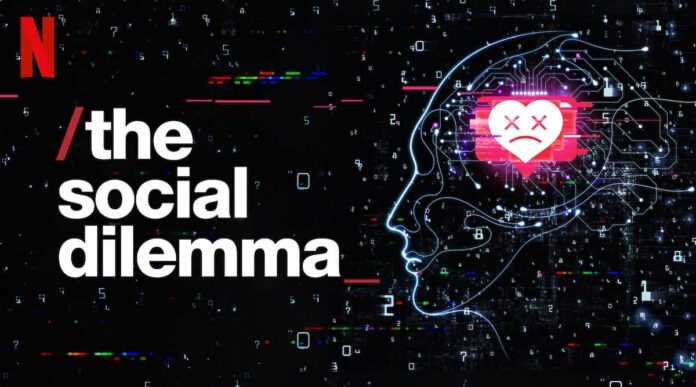Recently, the Netflix film The Social Dilemma received great attention and positive reviews because of its critique of mechanisms developed to monopolise user attention for-profit and their harms. It does so by interspersing interviews from tech gurus, industry experts, and academics along with the fictional story of a boy who becomes increasingly radicalised and alienated from his family because of social media. While we follow the boy, we also see three men who exist as a visual metaphor of AI who use the boy’s personal data to increase engagement for profit.
So why would Netflix stream and extensively advertise a movie which critiques the way tech companies use and store private data to track people’s movements? Why would any platform work against their own interests?
Of course, they aren’t. The documentary appropriates critiques of mass media and the culture industry and fuses it with liberal anxieties surrounding social media. These anxieties are especially with regards to the mainstreaming of the radical right and left-wing discourses. What emerges is an ahistorical and ideologically lacking movie that induces moral panic. Because of its endorsement of the neoliberal-capitalist social order, Social Dilemma also fails to posit any real solutions to the issue of surveillance capitalism.
Editing and Storytelling
Throughout the Social Dilemma, there are barely any quiet moments where the viewer can listen to the dialogue without visual and audio cues manipulating their responses. We also extensively follow Tristan Harris in staged scenes which make him appear more authentic and real. He does a magic trick, talks about his childhood, practices a Ted talk for no one. Other interviewees who are prominently featured- white industrialists and tech engineers- seem baffled at the start, as if they’re just grappling with their role. This creates an “authenticity hoax”, making them more trustworthy. Netflix describes the background music as “eerie” and the continued use of it along with additional sound signalling danger creates a sense of doom.

Of course, every film uses these, but not to the extent as the Social Dilemma. In the first half of the film, after each sentence from one interviewee, it cuts to a different interviewee. If this continues for more than a few minutes, they cut to a visual graphic. The documentary almost reads as if it was made like a social media platform in itself; the lack of continued and focused dialogue is meant to cater to the short attention spans of its viewers, making every moment as gratifying as possible, which the movie itself describes as “attention economy”. Because of this, other than a few repeated core concepts, the documentary uses many keywords in hopes that at least some of them will grab our attention. Very little time is actually spent on most of these concepts or their implications. Because of this people would come out of the film reaffirming their existing beliefs, and not be challenged.
Moral Panic vs Confronting Neoliberal Individualism
One of the repeated concerns of the film is the “addictive” nature of social media for young teens, and how it fuels their depression and makes them less “human”. As Eva Illouz notes, critiques of technology revolving around “humanness” come from a “longing for purity”. This is especially dangerous since such notions of “pure humans” do not serve disenfranchised groups. At one point, the movie compares social media to drug dealers. This uses the people’s paranoia around drugs because of anti-black and anti-Latinx propaganda and policies to induce moral panic.
This moral panic is furthered by the imagery used in the clips that follow the young boy. His propaganda hating older sister, who is disillusioned with social media, is left alone by her family after then pre-teen child breaks open glass to get her phone out after a minute of not using it. The family- and particularly the heterosexual white family- becomes “broken” because of their children’s alienation owing to social media.
“Though our wellbeing is inextricably linked to the lives of others, everywhere we are told that we will prosper through competitive self-interest and extreme individualism….Consumerism fills the social void. But far from curing the disease of isolation, it intensifies social comparison to the point at which, having consumed all else, we start to prey upon ourselves.”
-George Monbiot
As the movie suggests, there is definitely an issue with increasing social media addiction amongst teens. The Social Dilemma especially does an excellent job in explaining how seemingly normal aspects of social media, such as endless scrolling or notifications (addictive interface elements) fuel alienation. It also examines the dangers of automated changes, as well as how social media apps which are meant to “tweak” parts of your body body has increased cases of body dysmorphia.
But it misses that -much like the war on drugs- the issue cannot be confronted without confronting social structures as a whole. Here, individualisation of people occurs through late capitalism and is related to people’s increasing disconnect from our material reality, community (and not family), and politics. Social media is certainly part of this as it transforms average citizens into consumers in every aspect of their lives, but it is not unique.
Future of the Internet: Still Corporates?
Though the film spoke about how corporations are inherently designed for profit, and therefore will not care about the effects it has on people, they could that the internet should still be profit-driven. This isn’t surprising since the men who had most screen time are still making money in the industry. The few women or people of colour interviewed are mostly academics who barely got any screen time and their views were likely misrepresented. So, what these men pose is an internet with “more regulations and more competition”, where consumers can choose what’s right for them and their families.
If corporates are still making a profit off the Internet and privatising websites, what would be their source of income? The Social Dilemma gives the example of Wikipedia as a website that is “fundamentally good”, but Wikipedia exists on the principle that knowledge should be free and available to all. So, would they use advertisements? This doesn’t seem like a move in the right direction as the film itself critiques the model where users are both consumers as well as the product. Surely regulation of ads doesn’t change the way social media targets its users?
The second option would be the Netflix model, where everything exists behind a paywall, but with regulations prohibiting storing user data. However, media history already tells us why this would be a dangerous idea, with the story of Aaron Swartz; Swartz was on the CIA watchlist for his activism against privatisation of online data (stopping the Online Piracy Act) and free internet. After being targeted for two years for mass downloading articles from JStor, Swartz committed suicide. The state pursued Swartz for resisting privatisation to the point that he felt that the only option he had was death.
Ahistoricism and Misunderstanding Power Structures
The Social Dilemma takes an ahistorical approach in understanding how social media functions. Swartz’s case is a pivotal moment in media history as privatisation took a complete hold on the Internet since his death in 2012, but it’s not even mentioned in the documentary. One of the interviewees states that depression rates and the way people used social media changed drastically in the 2010s. She says that before, the internet was a “fun place for weirdos”, but doesn’t connect this shift to laws released at the same time that increased privatisation. This romanticisation of the “old internet” as a tool created for fun is ahistorical as well as it erases the internet’s origins as a surveillance tool created by the U.S Government in the 70s.
The documentary doesn’t look at history because of its lack of incentive to explore how oppressive structures function. It does highlight oppressive Governments’ use of social media for targeting people. But it also labels people who don’t believe in their Governments as “delusional”. Throughout the documentary, we follow a young white boy as he shifts from a loveable football player to a “radical centrist”- an amalgamation of both radical left and right positions. He doesn’t vote because he was targeted with advertisements (with a black lives matter symbol that says “don’t vote!”).
As the documentary reaches its final act, the boy is completely cut off from his family and goes to a protest where he is violently arrested. This is paralleled with videos of violent protests from different countries. Bizarrely, the conclusion that the Social Dilemma makes is that the violence is a result of echo chambers and that this is unique to this decade. At a conference, an unnamed man intervenes and states that while social media is a new tool of control, its effects are a continuation of mass media under late capitalism. The humanised Tristan, however, deems this “naive”, and so the audience does too.
In the end, the Social Dilemma is unable to grapple with the idea that the fundamentals liberal conception of “freedom”-the freedom of competitive markets which gives its consumers choices- might in itself be the cause for many of the issues we face.




























